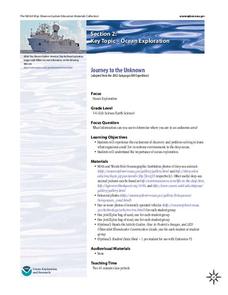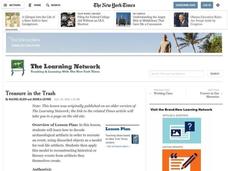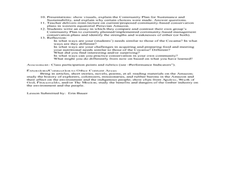Curated OER
Building an Underwater Habitat
Students investigate underwater habitats. In this underwater habitat lesson, students study Aquarius and design their own underwater habitat that can sustain life. Students work in groups and present their habitats to the class. Students...
Curated OER
Fossil Inferences
Fourth graders use their knowledge about fossils to arrange fossil pictures in sequence from oldest to youngest. They explain how fossils can be used to make inferences about past life, climate, geology, and environments and discover...
Curated OER
Living Light
Students explain bioluminescence. In this life science lesson, students discuss bioluminescence and conjure examples of organisms that carry this trait and how it is useful in their environment.
Curated OER
Build an Anchialine Pond
Students explore biology by conducting a nature experiment. In this pond examination lesson, students utilize recycled materials, play-doh and water to recreate a pond and its inhabitants. Students identify the different elements within...
Curated OER
Famous Quotes and Mottos
Students read about the accomplishments of John Paul Jones and the Continental Marines. They explore famous quotes and mottos, i.e. "Semper Fidelis." Students discuss other quotes or mottos by famous people in history. They discuss...
Curated OER
Dissolved Oxygen Lesson
Learners investigate what dissolved oxygen is and why it is important to aquatic life and what factors influence levels of dissolved oxygen in a lake. They study how to use MS Excel to make charts to show trends and correlations.
Curated OER
Environmental Science/Water Pollution
Young scholars study natural habitats, aquatic life, renewable and non-renewable resources. They discuss conservation efforts for sea otters and desert toad in this units.
NOAA
Journey to the Unknown
What's it like to be a deep-sea explorer? Tap into the imaginations of your fifth and sixth graders with a vivid activity, the second part of a six-part adventure. Learners close their eyes and submerge themselves in an expedition aboard...
Curated OER
The Formation And Types of Coral Reefs in Insular Southeast Asia and their Inhabitants
Students study the geological formation and inhabitants of the coral reefs in Southeast Asia. They investigate how the effects of weather and human activity on these ecological systems.
Curated OER
Transportation and African-American Migration
Students examine an aspect of either railroad or marine transportation (for example: routes, Pullman porters' work routines, or African-American merchant sailors) and evaluate their impact on migration in the United States.
Curated OER
The Inside Current
Eighth graders explore ocean currents and wind patterns. They discover the concept of systems to show how change in one component of a body of water, causes change in other components in that system. Students describe positive and...
Curated OER
Trash on Texas Beaches
Middle schoolers take a field trip to a local Texas beach. Using the trash and debris they find, they classify them based on specific criteria. In groups, they calculate the total for each category and determine the percentage of each...
Curated OER
Model Boats
Students analyze pictures of boats, jet skis, submarines, and marine animals. They explore what shapes move easily through water and determine how boats stay upright. Drawings and photographs of boats are collected by the pupils. They...
Curated OER
Spot the Differences
In this spot the difference worksheet, learners analyze pictures of two
different waterfowl and marine mammal images to see if they can find ten differences between the
two.
Curated OER
Spot the Differences
In this spot the difference worksheet, students analyze two pictures of sea creatures to determine the ten differences between two images.
Curated OER
A Comparison of Two Great Leaders: Mahatma Gandhi and Martin Luther King Jr.
Students explore these two leaders use of nonviolent protest techniques. They read about the life of King Jr. They view a slide show about the life of Gandhi. Compare/contrast the lives of these two men using a Venn diagram.
Curated OER
Internet Activity-Visit the Tidepools!
Students examine a virtual tidepool. In this tidepools instructional activity, students examine samples of tidepool organisms and discuss their characteristics. Students use the Internet to visit suggested websites on tidepools.
Curated OER
Treasure in the Trash
Students decode archaeological artifacts in order to recreate an event, using discarded objects as a model for real-life artifacts. They apply this model to reconstructing historical or literary events from artifacts they create.
Michigan Sea Grant
Fish Habitat and Humans
Strict habitat requirements are needed for the survival of fish populations and fish variety in the Great Lakes. Young scientists become experts in the basic needs of fish and understand how survival necessities can vary with different...
Curated OER
Life at Sea: Sores, Scabs, and Scurvy
Learners study the diseases that sailors contracted. They examine the ways that Captain Cook used to prevent illness in his crew.
Curated OER
Supermarkets, Sustenance and Sustainability
Students investigate jungles and the people who depend upon them. In this sustainability lesson, students research wild life conservation and discover the importance of a jungle to Amazonian people. Students create a group presentation...
Curated OER
Predators Among Us
Pupils study environmental science. In this ecosystems lesson, students discover how humans have an impact on life in the coral reef. They watch video clips and work on small group activities. This lesson includes links to the videos...
Curated OER
Fish Are Animals Too
Students create posters that show how a shark is a major predator in kelp forests and coral reefs after studying the food webs for these ecosystems. They determine that fish are important animals in the ocean's web of life.
Curated OER
Move To a Healthier Aquatic Balance
Fourth graders examine aquatic orgnaisms and how enviromental chages affect them. This factors include: temperature, Ph, oxygen, nutrients, and pollutants. They also explore habitat quality (erosion). Students compile data and create...

























